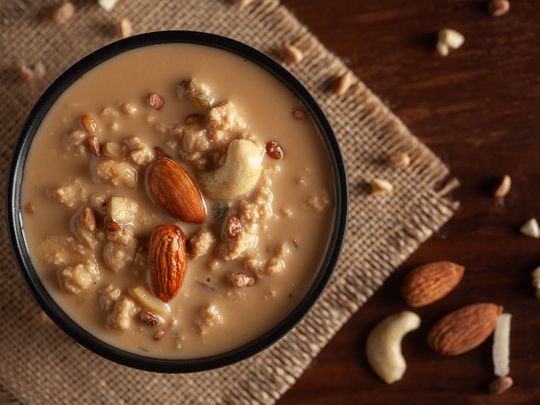Ingredients
3 central ingredients: Approximately 1 litre full fat milk, 50 grams of rice and 150 grams of jaggery
Notes: Since rice needs to be aromatic, Gobindobhog is preferred. But, we use Chini Gura which is available here. Traditionally Nolen Gur or date palm jaggery is used, but we use sugarcane jaggery. There is no sugar in this dish, as the flavour should not be overly sweet. We use a bit more milk as we like the payesh to be slightly runny.
2 supporting ingredients: 10 pieces each of cashew and golden raisins. These are not optional, but their quantity really depends on the family’s preference.
Note: We use less of these two only for flavour, ensuring that they don’t overpower the rice and jaggery flavours.
Last but not the least, 10-12 grams of ghee, which brings it all together.
Note: In many households a brand called Jharna Ghee is used. Here we found Buffo Ghee to be a good substitute.
Method
1. Wash and soak rice for 30 minutes (do not over wash the rice). Then dry the rice and mix with about 10-12 grams of ghee and keep aside.
2. Brown the cashew a bit by frying it in a little amount of ghee and keep aside. Soak the raisins in water.
3. Pour the milk in a deep pan and bring to boil. Then keep reducing the milk on medium flame for about 15-20 minutes. All the while you will need to stir the milk, so that it does not stick to the bottom or sides of the pan.
4. Then add the uncooked ghee rice into the milk, lower the flame and cook the rice while stirring gently. This will ensure that the rice starch is released to thicken the payesh. Make sure that the payesh does not stick to the sides and bottom of the pan.
5. The rice is cooked when it holds its shape but can be mashed easily between your fingers. It should take 15-20 minutes, but this is non-standard.
6. After the rice is cooked, turn off the heat and only then put the jaggery in (crush the jaggery before putting it into the payesh), add cashew and raisins, stir the three into the payesh gently and let the residual heat melt the jaggery.
7. Payesh is now ready. Remember cooking payesh requires a lot of patience and love.




